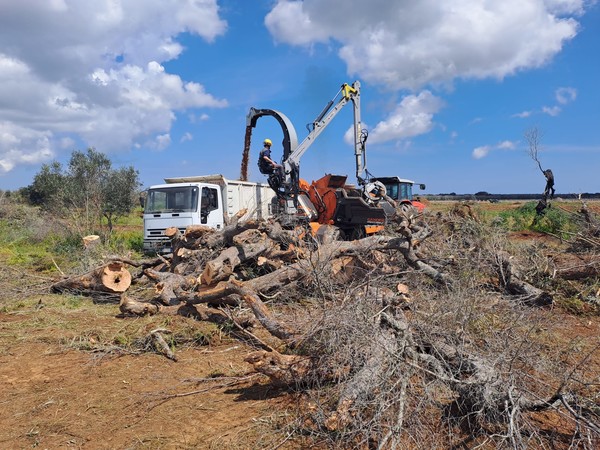
BRANCHES survey: energy independence linked to bioenergy
Even if energy costs returned close to pre-crisis levels, the economic shock was very severe and highlighted the role of the bioeconomy in supporting energy independence, local resources and communities with respect to this emergency. All this emerges clearly from a survey conducted for the BRANCHES project
In the summer 2022, the post-pandemic rebound and an escalation in the Ukrainian conflict determined a severe energy crisis. Within few months, gas and fuel prices climbed to unprecedented heights, endangering many businesses and causing general civil unrest. The traded price of natural gas reached 130 €/MWh from 40 €/MWh, which had been its stable price for over a decade. Diesel fuel sold at 2.2 €/litre at the pump, from the original 1.5 €/litre. Energy-demanding industries took the hardest hit and many had to suspend operations. European governments considered pausing or reversing their enlightened green policies and started looking again at coal or nuclear energy. In the meantime, climate change continued to plague the planet, and especially in the poorest countries. Even if prices have slowly returned near to their pre-crisis levels, the shock suffered by the European economy was brutal. This latest crisis highlighted the role of the bioeconomy in supporting energy independence and mitigating future shocks. That was the time when the financial and strategic benefits of local bioenergy eventually showed their worth. At the end of 2022, LUKE, CNR, ITABIA and the University of Warmia and Mazury conducted a survey among bioenergy businesses (see link: https://www.branchesproject.eu/blog/bioenergy-in-a-time-of-crisis). Overall, 18 enterprises were interviewed, selected among those showcased on the BRANCHES project webpage for their exemplary bioeconomy practices. Those 18 enterprises represented Finland, Italy and Poland and covered the wood energy, straw energy and biogas sectors, as well as other non-energy value chains. The practices represented in the survey cover a wide range of bioeconomy value chains: nevertheless the interviews are case-specific and caution should be taken when trying to generalize their results. Very briefly our survey indicated that all respondents declared their companies had plans for immediate expansion. Many Italian entrepreneurs decided to expand their pelleting plants, or to install a new plant if they did not have one already. Polish entrepreneurs declared they were doubling their power generation capacity. In Finland, the production of energy wood harvesters expanded and so did the use of local wood for ecological buildings.
Biofuels and territory
Bioenergy users suffered a much smaller energy cost increase than did the users of conventional energy (oil or natural gas). In Poland, residents connected to a biomass heating network could keep their houses warm at less than half the cost incurred by conventional energy users. In Italy, locally produced pellet was sold at 40% less than imported pellet. The latter was priced at 12 € per 15 kg bag, which was three times the pre-crisis cost. In fact, pellet bags almost disappeared from the shelves of Italian distributors and supply had to be rationed - except where local production had been set up. Bioenergy plants had to expand the share of locally sourced material, due to the sudden drying out of all wood import channels. That had a strong and positive impact on the local rural economy that had been choked by global prices until recently. Energy wood prices increased by at least 20%, providing sufficient motivation to forest owners and wood suppliers to overcome the obstacles that had previously constrained correct exploitation and blocked access to an otherwise abundant local resource. By and large, strict regulations and control, engrained professionalism and a land tenure system rooted on sustainable management prevented abuse, over-exploitation and the indiscriminate pillaging of natural resources. The emergency did not result in the suspension of traditional good practice, but it rather offered the financial conditions that enabled its sound application (e.g. early thinning operations, sanitary cuts).
Bioenergy and energy independence
Despite an increase of management cost ranging from 20% to >100%, bioenergy suppliers dramatically increased the financial sustainability of their operations, because the growth of energy sales was much higher than the increase in fuel and material cost incurred by their operation. That was especially the case of heat sales, which were not bound by fixed infeed tariffs as power sales were. For instance, Italian cogeneration plants saw their internal power consumption cost quadruple, while still being unable to raise the revenues obtained from power generation. On the other hand, wise use of residual heat allowed such a large increase of revenues from heat sales that profits would eventually triple. Polish biogas plants could double their revenues, as well. Autarchic energy supply allowed mitigating the increased cost of power purchases anywhere from 25% to 100%, depending on the level of energy independence. In that regard, investment in a supplementary photovoltaic plant assisted with cutting the cost of internal power consumption, especially where no power was generated from biomass or where all power had already been committed to the grid at an inflexible rate. The key success factor for all respondents was control of the fuel supply, always obtained from abundant locally available resources, such as local forests, agricultural crops or animal waste. In that regard, the dramatic price increase (+300%) of imported pellet is most telling: due to their lower energy density and decentralized availability, wood-based fuels are much more difficult to source and transport compared with fossil fuels. Once a dominant import source is shut down, it is very difficult to find a replacement. Therefore, wood-based bioenergy chains should stay local: if they are fed through imports they become as vulnerable as fossil fuel chains.
Machines for mobilizing biomass
In all the countries involved in the survey, modern mechanization represents a central element for making biomass procurement operations efficient and economically advantageous. In this respect, in Finland the sales of a specific energy wood harvesting machine increased by 20%. In Italy, local forestry companies hired additional staff, increasing their personnel by over 25% and dramatically contributing to employment rates in economically disadvantaged mountain areas.








